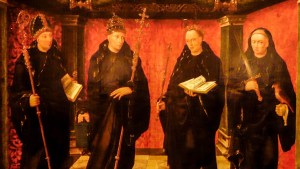Help Aleteia continue its mission by making a tax-deductible donation. In this way, Aleteia's future will be yours as well.
*Your donation is tax deductible!
Established in the 13th century by St. Francis of Assisi, the Franciscan family is a large one, with thousands of religious communities, monastic and apostolic, who claim Francis as their inspiration.
After an extraordinary conversion, Francis became a zealous preacher, further inflamed by the Holy Spirit after hearing a sermon on the following passage from the Gospel of Matthew.
Take no gold, nor silver, nor copper in your belts, no bag for your journey, nor two tunics, nor sandals, nor a staff; for the laborer deserves his food. (Matthew 10:9-10)
This “troubadour of God” took these words literally and dedicated himself to a life of radical poverty, seeking to give God everything and depend solely on divine providence for the necessities of life.
This passage from the Gospels is one of the principal driving forces behind all Franciscan movements, seeking to live a life of evangelical simplicity, proclaiming the Gospel both in word and deed.
Here is a brief guide to the Franciscans, detailing the basics of this beloved religious order.
Names & Abbreviations: Order of Friars Minor, O.F.M.; Order of Friars Minor Capuchin, O.F.M. Cap; Friars Minor Conventual, O.F.M. Conv; Franciscans, Order of St. Clare, O.S.C., Poor Clares; Secular Franciscan Order, O.F.S. (Note: This is just a short sampling of the primary branches of the Franciscan Order. There are thousands more names and abbreviations.)
Date of Foundation(s): 1209
Founder(s): St. Francis of Assisi and St. Clare of Assisi
Motto & Charism: Deus meus et omnia(My God and My All)
According to the Capuchins’ website, “The fraternal Gospel life is the unifying identity of all Franciscans.” Furthermore, their constitutions illustrate a common Franciscan ideal that is similar to many of the Franciscan congregations in existence today.
Let us strive to give priority to a life of prayer, especially contemplative prayer, to cultivate, together with a spirit of minority, radical poverty, both personal and communal; and, out of love of the Lord’s cross, to manifest a life of austerity and joyful penance … While exercising among ourselves the freedom of brothers, let us joyfully live among the poor, the powerless and the weak, sharing their life, and let us maintain our special approach to people. In many ways, above all in the work of evangelization, let us promote an apostolic dynamism that is carried out in a spirit of service.
Besides a devotion to the poor and most vulnerable of society, Franciscans are also marked by their devotion to Jesus’ presence in the Holy Eucharist, which can be seen in the many Franciscan communities devoted to perpetual Eucharistic adoration.

Read more:
What is perpetual adoration and why is it deeply personal?
Examples of Franciscan Communities: A small selection of Franciscan communities include Conventual Franciscans, Franciscan Friars of the United States of America, Capuchin Franciscans, Franciscan Friars of the Renewal, Poor Clare Colletines, Poor Clares of Perpetual Adoration, Franciscan Friars Australia, Order of Friars Minor in Great Britain

Read more:
Exclusive Photos: An extraordinary ordination in NYC
Famous Franciscans: St. Bonaventure, St. Anthony of Padua, St. Junipero Serra, St. Padre Pio, St. Maximillian Kolbe, St. Elizabeth of Hungary, Bl. Duns Scotus, and Bl. Solanus Casey (to name a few).

Read more:
Here’s what you need to know about the Dominicans

Read more:
What you need to know about the Order of St. Benedict

